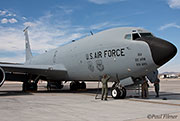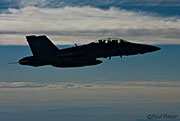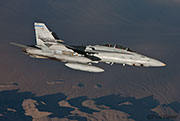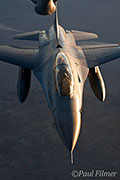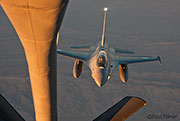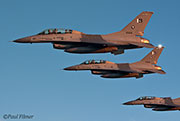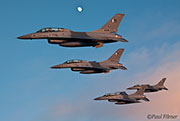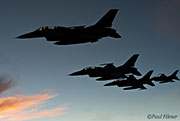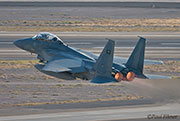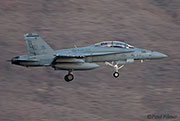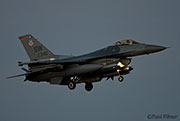Red Flag 10-4 was the good and the bad. Good because we had the day/day launches which gives us two bites at the launches and recoveries, although the morning light can be extremely tough, but bad because it is usually the hottest time of the year.
It's been a few months since the last Red Flag at Nellis but I managed to secure three days to try to capture some good angles at this sometimes frustrating place to shoot. I arrived at McCarran at 22:00 on Sunday where the temperature was a barmy 41 degrees C (107F). Coupled with the announcement that my wonderful car rental company had run out of cars things were looking grim. After waiting around for their van to take me to my hotel for ten minutes, they told me a car had turned up after all. It wasn't the best vehicle for the job, being black, but I just wanted to get to the hotel to sleep by this time.
The next morning after breakfast the usual suspects and myself decided to check out the 10:00 northerly launch from the Las Vegas Motor Speedway. This always proves very difficult as the aircraft can be high but are also backlit; a photographers dream. I probably shot only the E-3 and a couple of F-16s who were given a Flex turnout, but this is to be expected in these very difficult shooting conditions. When they depart to the north the morning is effectively a scrub.
We spied the four Royal Singapore Air Force H-47s parked on the eastern ramp and took a punt at guessing that their departure would be via the north east of the field, so took a drive north almost to the freeway to hang out at one of the highest points in the area in case they decided to fly by at a low altitude. Unfortunately they decided to stay stubbornly on the ground, so, due to the heat, went shopping for better hats to combat the relentless sun. The afternoon as expected turned out to provide better shooting opportunities and I managed to secure some nice low light recoveries against the mountains that more than made up for the bad morning light.
The stars of this Flag were undoubtedly the Pakistan Air Force with their F-16Bs. This is the first time they have participated in a Red Flag exercise and they bought six jets and around 100 ground support personnel. They flew to Nellis AFB via Lajes Field AFB in the Azores and were hosted on the stopover by the 65th Operations Support Squadron. This was the first time the Pakistan Air Force have ever used this base as transit point. All the pilots were well trained in advance for the long transatlantic crossing that was seen as a symbolic leg for this huge undertaking.
Six aircraft were brought over and during the first seven days two sorties with four aircraft were flown each day. Surprisingly one of the airframes did not fly at all and one other flew only one mission, so the remaining four jets were used almost exclusively, which is a testament to the reliability of the aircraft and the skill of the maintenance crews.
These particular F-16Bs are block 15 machines and were part of the final production run of 40 Bs. They were delivered in the early 1980s and after initial aircrew training at Hill AFB, UT were delivered to Pakistan between 1983 and 1986. US embargos later on in 1990 would mean that parts and support would dry up, but the ever-resourceful Pakistanis still managed to keep all their western equipment flying. This embargo, called the Pressler Amendment, also stopped an order of 71 newer F-16s that had been already ordered and the finished airframes ended up in AMARC. These aircraft would eventually find their way to the US Navy in 2002 for use as aggressors at NAS Fallon with NSAWC; these were a mixture of A and B models. This embargo has since been lifted and new C/D models have now started to arrive in Pakistan.
The Pakistan Air Force is no stranger to working in conflicts throughout their history but as a spokesperson told us, being able to participate in this exercise has allowed then to learn from the strengths of others. Relationships have of course been very important in this political world, especially after the past embargos, and the Pakistan Air Force personnel have had the opportunity to understand their allies better from both a cultural and professional level.
In the afternoon I had a tanker flight arranged and the schedule showed that we should be receiving Pakistan Air Force F-16s, Royal Saudi Air Force F-15s, US Navy EA-18G Growlers and US Marine Corps F/A-18s; this would be a real quality haul! I reported back to the main gate at 14:30 for my 17:30 flight, and with me would be a Boeing video guy who was here to shoot the Saudis, a PAO photographer from the US Navy for the Growlers, and our PAO escort who was actually from Shaw but on temporary assignment to the Nellis PAO office for this Flag.
We met our flight crew in the Operations building and were invited to attend their pre-flight brief. They showed us on the map that our tanker holding track would skirt really close to the Groom Lake restricted zone. They told us that if they so much as clip that area they would be grounded for the rest of the exercise. There was confusion at first as their commander had advised them that we would be there to take photos of the crew. They made a phone call to the boss to relay the fact that we were here to take photos of the aircraft that they would be re-fueling, but were then advised that we couldn't take photos of any foreign aircraft. Luckily at this point our main PAO contact arrived back in Base Ops and sorted out that in fact there were no restrictions on what we could shoot, and in fact the Pakistan Air Force had explicitly asked to be shot. Phew!
Just before the mission got underway we leaned that the Growlers and the Saudis had scrubbed their requirement to fuel, but thankfully the Pakistanis were still in schedule. A real blow but that's aviation and luckily the main stars were still on schedule.
Our flight crew was Instructor Pilot Capt. Nicholas "KOKO" Motlagh, Pilot 1st Lt. Mattew "Rook" Douglass and Instructor Boom Operator Staff Sgt. Logan "Crunch" Berry. This flight was in fact Lt. Douglass' first ever KC-135 mission and he performed the take-off on 21L with the required right turnout to avoid the city. The aircraft was stifling hot on the ground even with the cargo door and over-wing exits open to allow the breeze to circulate, but as we climbed the temperature began to slowly drop until 30 minutes later when the temperature was nigh on perfect.
We started our refueling track at flight level 240 waiting for our first customers. After about 40 minutes three specks appeared behind us and low down. These aircraft were the F/A-18 Hornets of VFMA(AW)-225 based at MCAS Miramar and it was surprising just how quickly they formed up on our port wing. The aircraft we were in was fitted with the outboard Multi-Point Refueling System pods (MIPRS), which allows two aircraft that require the basket (hose and drogue) to be refueled simultaneously. The KC-135 can also trail a single basket from the boom, but this needs to be fitted on the ground and stops use of the boom for mixed refueling missions. Unfortunately on the KC-135 when the aircraft are plugged-in to the baskets there is nowhere inside the aircraft that you can actually see the aircraft to take any photos, as they are in a perfect blind spot for all the windows. The boomer uses a series of mirrors to see when the aircraft has contact.
After about 15 minutes the aircraft were topped up and ready to continue the fight on the ranges. The port hose unfortunately refused to retract, so the crew needed to coordinate an emergency procedure to see if they could reel it in. If this failed they would have a choice to either cut it over a remote area, something that isn't in short supply in this area, but still somewhere that a recovery crew can recover the hose, or elect to land back at base with the hose and basket trailing. The former is the preferred option as when landing with the trailing equipment there is the possibility of damaging the elevator once it touches the runway and starts to be thrown around and bounce back up. After a series of procedures including a full reboot of the system the mechanism that reels in the hose sprang into life, much to everyone's relief.
We continued our track waiting for our next customers the Pakistan Air Force with their F-16s. About 45 minutes later the small swarm of four aircraft appeared and formed up on our port wing. Unfortunately the side windows in this aircraft have suffered the scratches from photographers that have had filters attached to their lenses, with the result being that they are nigh on impossible to shoot through as there are literally no clear patches. I had already spoken to the crew on the ground about shooting over the back of their cockpit seats through the side windows and they said this was not a problem. This was my saving grace and my pilot also asked the aircraft if they could move forward in their formation so that photos could be taken. So while the first aircraft took the boom the remaining three formatted for me just as the light was becoming real soft as the sun was ready to set.
I went back to the boomers position to shoot number two as he was fueling and also caught number three as he positioned for the boom. Then it was back ton the cockpit to catch them in formation on the starboard wing. When they were finished our pilot asked if I wanted them to ask the Pakistanis to do anything. I replied that if they could move forward again just as they had done on the port side that would be perfect, if of course they had the time to spend before their next part of the mission. They did this in glorious sunset light, both backlit with the red sky and after the turn with the light shining perfectly on the airframes. Perfect!
We landed back at Nellis AFB after dark at around 20:30 after a flight of just over three hours. By the time I got off base I was too tired to eat so it was back to the hotel for a shower and a well earned sleep.
The next morning we were between the runways with nowhere to hide from the relentless sun except for the thin lines of shade next to the bus and the small tower. The other exotic players were the Royal Saudi Air Force with F-15S aircraft who last came to Red Flag for RF08-2.2 back in February 2008.
During the two-week exercise the temperature was above 100 degrees F every day and one of the days I was in the desert it touched 112F with a 30mph wind. It felt like an industrial hair-dryer and I would imagine that for both the Saudis and the Pakistanis, this would be close to weather they are used to at home, but this, or course, would be valuable for any other squadrons taking part with not only very real war-games, but also the kind of temperatures to expect in current theatre operations.
Joining the Pakistan Air Force and Royal Saudi Air Force in the interdiction role was the Republic of Singapore Air Force (RSAF) with a mixture of F-16Cs and Ds based in the USA at Luke AFB, Arizona.
The Royal Singapore Air Force also bought four CH-47SD helicopters that are based at Grand Prairie AASF in Texas for operation in the Command and Control role. Joining them in this task was a single MC-130P from the California ANG 129RQS based at NAS Moffett Field, and two E-3s from Tinker and a solo E-3 operated by NATO. On a couple of missions the E-3s would overlap with one departing long before the main launch followed by the second machine just before main launch as is normal. The first aircraft would then return part way though the launch. We normally only see two E-3s here for each Flag with only one flying, but the additional aircraft obviously allows longer coverage with more crews exposed to the task.
The other players for RF10-4 were in the SEAD (Suppression of Enemy Air Defence) role with the traditional EA-6Bs this time from VMAQ-3 at MCAS Cherry Point alongside the new EA-18Gs from VAQ-132 at NAS Whidbey Island, WA and these aircraft often returned in the break together in a dissimilar formation. Also in this role were the 77FS F-16CMs from Shaw AFB who seem to permanently deployed to Nellis these days, although the strange photo restrictions that we have had to live with for the past year were suddenly lifted as the exercise began.
I'm indebted to Capt. Nick "KOKO" Motlagh for his help directing the traffic on our mission and thanks also must be extended to Capt. Ashley Norris and SrA Michael Charles, without whom many of these photos would not have been possible.
The HL F-16s were participating in Green Flag.

